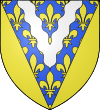Val-de-Marne
| Val-de-Marne Marne | ||
|---|---|---|
| Department | ||
|
Prefecture building of the Val-de-Marne department, in Créteil | ||
| ||
 Location of Val-de-Marne in France | ||
| Coordinates: 48°45′N 2°25′E / 48.750°N 2.417°ECoordinates: 48°45′N 2°25′E / 48.750°N 2.417°E | ||
| Country | France | |
| Region | Île-de-France | |
| Prefecture | Créteil | |
| Subprefectures |
L'Haÿ-les-Roses Nogent-sur-Marne | |
| Government | ||
| • President of the General Council | Christian Favier (PCF) | |
| Area1 | ||
| • Total | 245 km2 (95 sq mi) | |
| Population (2013) | ||
| • Total | 1,354,005 | |
| • Rank | 11th | |
| • Density | 5,500/km2 (14,000/sq mi) | |
| Time zone | CET (UTC+1) | |
| • Summer (DST) | CEST (UTC+2) | |
| Department number | 94 | |
| Arrondissements | 3 | |
| Cantons | 25 | |
| Communes | 47 | |
| ^1 French Land Register data, which exclude estuaries, and lakes, ponds, and glaciers larger than 1 km2 | ||
Val-de-Marne (French pronunciation: [val.də.maʁn]) is a French department, named after the Marne River, located in the Île-de-France region. The department is situated to the southeast of the city of Paris.
Geography
Val-de-Marne is, together with Seine-Saint-Denis and Hauts-de-Seine, one of three small departments in Île-de-France that form a ring around Paris, known as the Petite Couronne (i.e. "inner ring"). Since January 1, 2016 Val de Marne is included in Métropole du Grand Paris

Administration
Val-de-Marne is made up of 3 departmental arrondissements and 47 communes:

History
Val-de-Marne was created in January 1968, through the implementation of a law passed in July 1964. Positioned to the south-east of the Paris ring road (and the line of the old city walls), it was formed from the southern-eastern part of the (previously much larger) Seine department, together with a small portion taken from the broken-up department of Seine-et-Oise.
Demographics
Place of birth of residents
| |||||||||||||||||||
Tourism


- An oddity from the Musée Fragonard d'Alfort

- Paris Zoological Park (formerly Vincennes Zoo)
See also
External links
- (French) Prefecture
- (French) General Council
- (French) Citizen Blog

